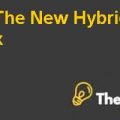DERIVATIVES AND RISK ANALYSIS Case Solution
- The annual cash flows at the end of the year 2 by using the arbitrage opportunity in which the value of the AIG bonds, has reduced to 20 million dollars from 100 million dollars, and it will be $3,977,641 because the annual cash flows earned from the AIG bonds are higher than the annual cash outflow to the CDS bonds. The calculations are shown in the following table, which also shows the annual profit of around 4 million-dollars in the second year.
Table 1.7
| Principal value | $ 20 | million |
| Maturity | 5 | years |
| AIG Bonds | ($22.05) | |
| CDS Bonds | ($110.69) | |
| Number of bonds purchased of AIG | 4,535,921 | |
| Number of bonds purchased of CDS | 903,457 | |
| AIG Bonds rate | 5.50% | |
| LIBOR | 3.25% | |
| CDS Bonds rate | 5.60% | |
| Treasury Rate | 4.35% | |
| 5 year swap rate | 4.80% | |
| Annual return if AIG Purchased (Annual Cash Flows) | $ 4,989,513 | |
| Annual return if CDS Purchased | $1,011,872 | |
| Difference (Income) | $ 3,977,641 |
PART B – APPLICATION ANALYSIS
Question 1
According to the given scenario; the swap includes a fixed receipts and payments, based on floating rate, i.e. LIBOR. The swap can be replication by having two different securities with short and long position, i.e. the investor can sell short a security at LIBOR rate and long the fixed rate security. This can be understood using the detailed example as given below:
Current Hypothetical Situation:
The swap terms and conditions for floating rate payer includes the Libor rate, which gets changed after every six month tenure and receives the fixed annual interest of 6% for 3 years, with principal amount of $1000.
Swap Replication:
Sell short a $1000 face value security with coupon payments based on the LIBOR, whereby the coupon payment are reset after 6 months. Similarly, buy a 3 years security with 6% annual interest payments, with a maturity value of $1000.
| Cash Flows for a LIBOR Rate Payer | |||||||
| Swap (Payments and Receipts) | Swap Replication | ||||||
| Time Period
Months |
Hypothetical Floating Rate | Pay | Receive | Long 3 years security
|
Short 6 – Months security | ||
| Face Value | Coupon | Face Value | Coupon | ||||
| 0 | 2% | 0 | 0 | -$1000 | +$1000 | ||
| 6 | 3% | $10 | $30 | +$30 | -$1000
+$1000 |
-$10 | |
| 12 | 4% | $15 | $30 | +$30 | -$15 | ||
| 18 | 5% | $20 | $30 | +$30 | -$1000
+$1000 |
-$20 | |
| 24 | 6% | $25 | $30 | +$30 | -$1000
+$1000 |
-$25 | |
| 30 | 7% | $30 | $30 | +$30 | -$1000
+$1000 |
-$30 | |
| 36 | $35 | $30 | +$1000 | +$30 | -$1000
+$1000 |
-$35 | |
In this hypothetical situation, maintaining a long position, i.e. buying a 6% fixed annual coupon will generate a $30 semiannual cash flow for the investor for a period of 3 years. On the other hand, maintaining a short position or selling a floating rate security based on LIBOR would require the investors to pay the coupon at 6-months’ hypothetical rate, i.e. at the end of 6 months; the investor would have to pay $10 based on 2% floating rate. Afterwards, the security is sold and purchased back at a new floating rate after each 6 months’ time period. This results in the floating rate interest payments and a fixed rate coupon receipts by an investor, in replication to the mentioned swap.
The other possible strategy is to use a series of puts on the securities. The series of puts are similar to the caps placed on the floating interest rates. In the put option, the investor can sell the security whenever he has the negative sentiment about the rising interest rates and decline in prices of the securities.
Question 2
Investor usually prefers government securities because of the risk free rates offered by the government. It is believed that there are no chances of default by the government, but still there can be default as the bond is not completely risk free, which would lead the bonds towards being traded at the discounted prices. Investors can use other ways in order to earn the risk free rate, as offered by the government bonds. It could be done through replication, i.e. combining two or more securities or creating a portfolio to earn the similar rate of return........................
DERIVATIVES AND RISK ANALYSIS Case Solution
This is just a sample partial case solution. Please place the order on the website to order your own originally done case solution.













